Nebraska is a state known for its vast prairies, rolling hills, and diverse wildlife, including a variety of owl species that inhabit the area. From the small and cute Northern Saw-whet Owl to the powerful and majestic Great Horned Owl, these birds of prey are an important part of Nebraska’s ecosystem and a popular subject for birdwatchers and nature enthusiasts.
In this post, we will explore the different types of owls found in Nebraska, their habitats, behaviors, and conservation status. We’ll also share some tips on how to spot and identify these elusive creatures in the wild, and provide some resources for further reading and exploration.
Whether you’re an avid birdwatcher, a wildlife enthusiast, or just curious about the natural world, we invite you to join us on a journey to discover the fascinating world of owls in Nebraska!
9 Types of Owls in Nebraska:
- Great Horned Owl
- Barn Owl
- Eastern Screech Owl
- Barred Owl
- Northern Saw-Whet Owl
- Long-Eared Owl
- Short-Eared Owl
- Snowy Owl
- Barred Owl
Great Horned Owl
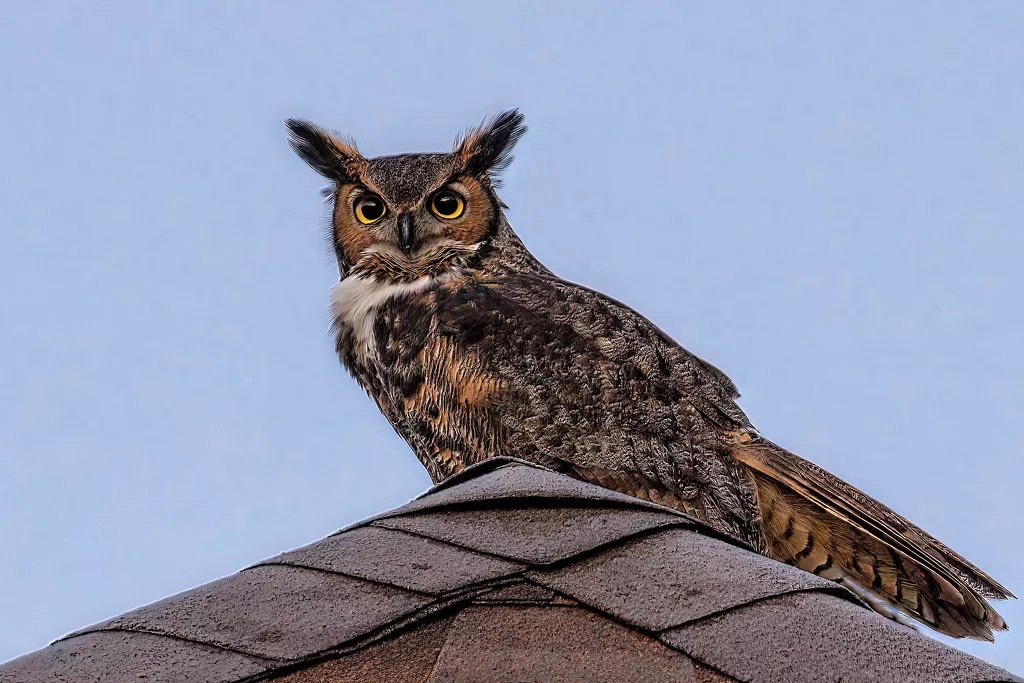
Image Source
- Scientific name: Bubo virginianus
- Life span: up to 13 years in the wild
- Size: length of 18-25 inches, wingspan of 36-60 inches
- Weight: 2-5.5 lbs
- Origin: North, Central, and South America
Because of its depiction in films like the Harry Potter series and its distinctive hoot, the great horned owl is well recognized. These enormous owls have a maximum weight of five and a half pounds. They can take down ferocious prey like ospreys and falcons because they have powerful claws and good flying abilities.
Once they get something in their claws, it takes 28 pounds of power to pull them apart.
From Mexico to northern Alaska, these birds may be found across North America. It lives in deserts, mountains, woodlands, and plains and is one of the most widespread owls. The great horned owl is equally at home in urban environments, suburban regions, and natural places.
All of this suggests that your chances of seeing one are excellent.
The great horned owl has golden eyes and long hair around the ears. They may have a body that is cream or light grey with bars that are grey, cinnamon, or both.
Contrary to what you may have heard, they can’t really turn their heads 360 degrees, in case you were curious. Yet, they can spin their heads 180 degrees which seems to be rotating their heads entirely around. These birds move their heads back and forth because they are unable to shift their eyes from side to side.
Barn Owl
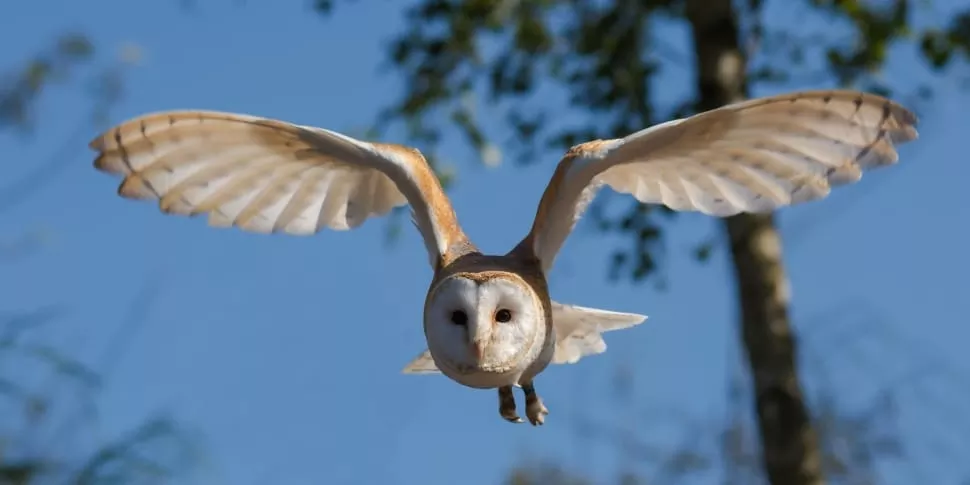
Image Source
- Scientific name: Tyto alba
- Life span: up to 20 years in captivity
- Size: length of 12-16 inches, wingspan of 39-49 inches
- Weight: 0.5-1.4 lbs
- Origin: worldwide distribution
The barn owl earned its name because it prefers to reside in abandoned barns and other structures in rural regions. They also build their nests in tree cavities. They search for prey by flying over wide spaces and listening and have great hearing as you could imagine.
A barn owl may be identified by its distinctive face. They have heart-shaped faces made of pure white, with big, black eyes. Their back and wings are rather speckled and either grey, golden, or cinnamon in color. They seem all-white from below while they are flying because their breast and the undersides of their wings are both white. In contrast to the great horned owl, they lack ear tufts.
Barn owl chicks will go far from their nest to discover their own territory, but once they locate a place they like, they remain there their whole lives.
Except for a few locations in a few of the central northern states, you can see barn owls everywhere throughout the US and Mexico.
Eastern Screech Owl
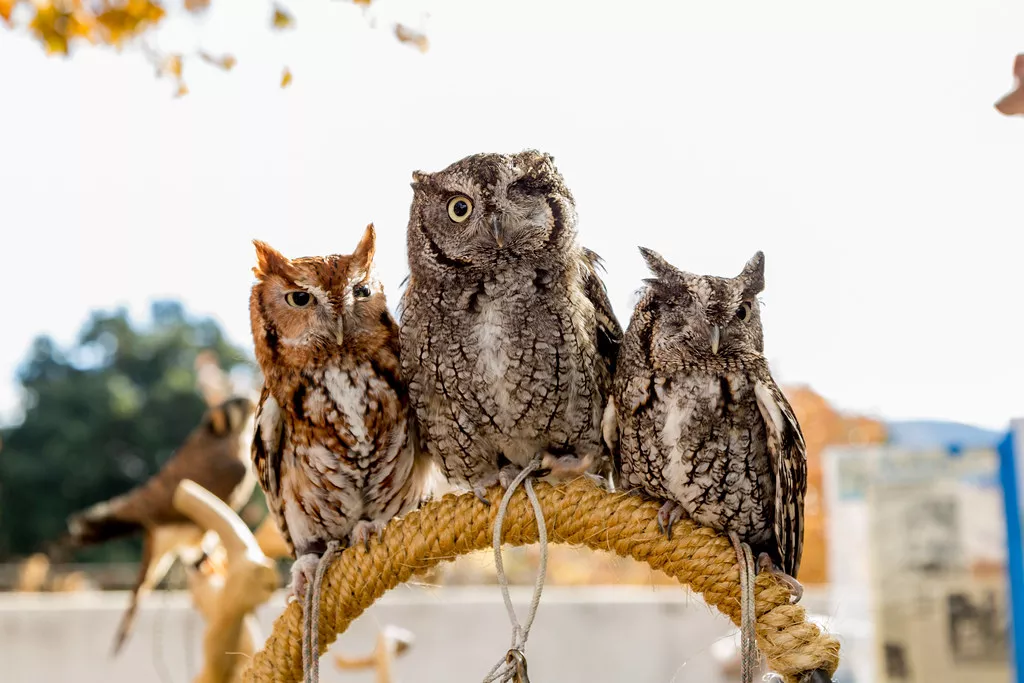
Image Source
- Scientific name: Megascops asio
- Life span: up to 14 years in the wild
- Size: length of 6.5-10 inches, wingspan of 18-24 inches
- Weight: 4-8 oz
- Origin: eastern North America
As one would anticipate, the eastern screech owl is related to the western screech owl. With a little overlap in the Rocky Mountains between their western relative, this owl resides on the east side of those mountains.
The eastern screech owl is a skilled concealer. They seamlessly blend into the bark of the trees where they prefer to perch and build their nest thanks to their grey or reddish-brown mottling. You may not even notice them until you get a glimpse of their glowing, brilliant yellow eyes.
They have a golden beak, noticeable ear tufts, and a black V between their eyes.
These owls hunt at night, which makes it extremely harder to observe them. The best course of action is to listen for their whiny trill call.
If you don’t like bird watching at night, take a closer look at the tree cavities as you stroll through their natural habitat. They can be seen while they snooze the day away.
Barred Owl
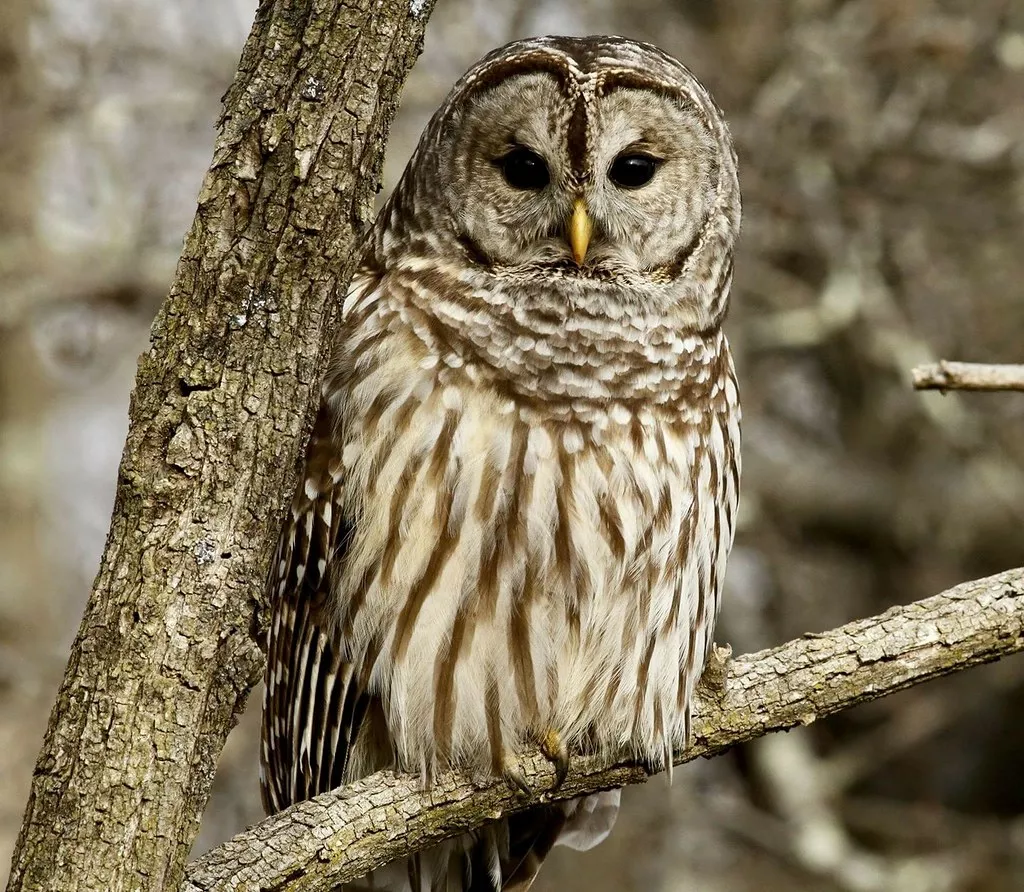
Image Source
- Scientific name: Strix varia
- Life span: up to 24 years in captivity
- Size: length of 16-25 inches, wingspan of 38-49 inches
- Weight: 1-2 lbs
- Origin: North America
The great horned owl and the barred owl are almost the same size, but the barred owl weighs significantly less. They have prominent bars all over their body and are a mottled brown and white color. On the rest of their bodies, the breasts’ bars are both vertical and horizontal.
These birds are not loud ones. While they often remain silent, sometimes you may hear them calling out throughout the day.
Barred owls like dense forests, whether they are in a marsh or high on a mountain. They are not seen in urban areas or on plains. They are widespread throughout the eastern US and as far north as Canada. The birds’ range has grown recently, and now the Pacific Northwest is home to colonies of them as well. they are non-migratory birds and settle in one location for all their lives. They will, however, travel great distances to hunt if they are unable to obtain food.
Northern Saw-Whet Owl

Image Source
- Scientific name: Aegolius acadicus
- Life span: up to 7 years in the wild
- Size: length of 7-8 inches, wingspan of 16-18 inches
- Weight: 2.3-5.3 oz
- Origin: North America
The body of a northern saw-whet owl is mottled brown and white, and it is little, approximately the size of a robin. They have heart-shaped faces with large golden eyes and a little white V-mark between their eyes.
They are hard to spot, particularly because they hunt at night, but you may tell they are around if you hear their harsh cry. If you look closely, you may be able to see them since they build their nests in tree holes at around eye level during the day.
Don’t search for them in open spaces or urban areas since they exclusively inhabit woods, especially old forests. They travel long distances for breeding and eat tiny rodents like shrews and mice. Moreover, They will also consume sparrows, waxwings, chickadees, and juncos.
They are found all throughout the United States, with small breeding populations in the South and widespread permanent populations in the North, including the Rocky Mountains and western Coastal ranges.
Long-Eared Owl
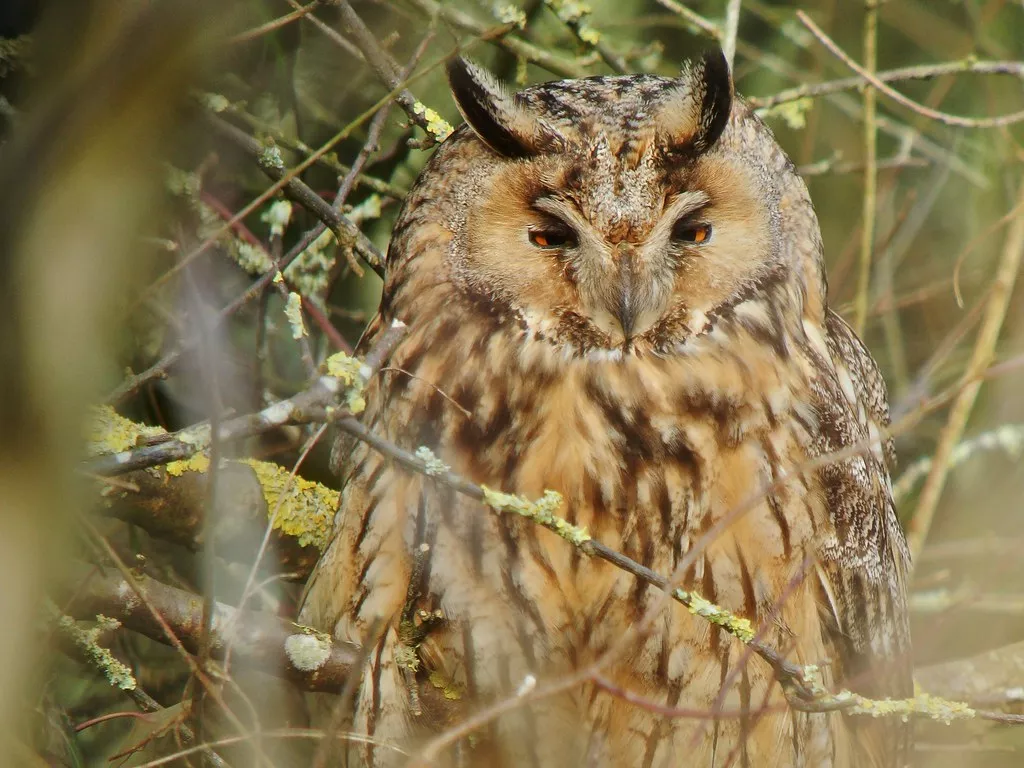
Image Source
- Scientific name: Asio otus
- Life span: up to 10 years in the wild
- Size: length of 13-16 inches, wingspan of 35-39 inches
- Weight: 7-15 oz
- Origin: widespread across North America, Europe, and Asia.
The term “long-eared owl” comes from the extremely lengthy ear tufts on these birds. With hints of buff or orange, the tufts are mostly black and have two white lines between their bright eyes.
They have spotted and thin brown bodies. These nocturnal raptors forage on meadows or open spaces while nesting in trees.
Long-Eared Owls often make hoots, squeals, and barks that are easy to recognize. They can fly very long distances, although they typically only migrate at night. Birds that migrated from Canada to Mexico in a single year have been discovered by researchers.
Short-Eared Owl
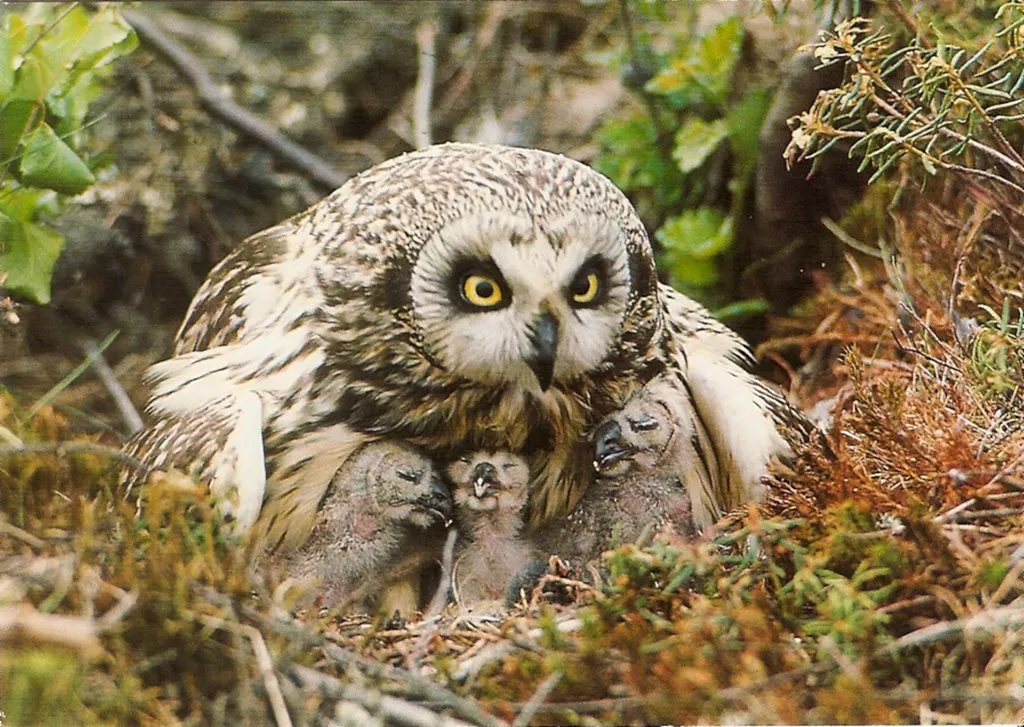
Image Source
- Scientific name: Asio flammeus
- Life span: up to 10 years in the wild
- Size: length of 13-17 inches, wingspan of 33-43 inches
- Weight: 7-16 oz
- Origin: North and South America, Europe, and Asia
You were correct to assume that these owls had little ear tufts. Owls have ear tufts that assist guide sound to their ears so they can hear prospective predators and engage in hunting. The ear tufts of short-eared owls are tiny and resemble little horns.
These owls may be identified by their characteristic brown and white mottling that is bordered by black bars. The eyes are golden and have heavy black outlines around the cream-colored face.
Their unusual appearance makes it simpler to notice them, but the fact that they are active throughout the day makes it much easier to see them. They also have a distinctive flying pattern that is similar to a moth, which makes identification much easier.
Short-Eared Owls don’t love woody places as many owls do. They like wide-open spaces like meadows and fields where they may sit on the ground and listen for potential prey. Then, in order to capture their prey, they soar up and plunge down. Even their nests are underground.
Snowy Owl
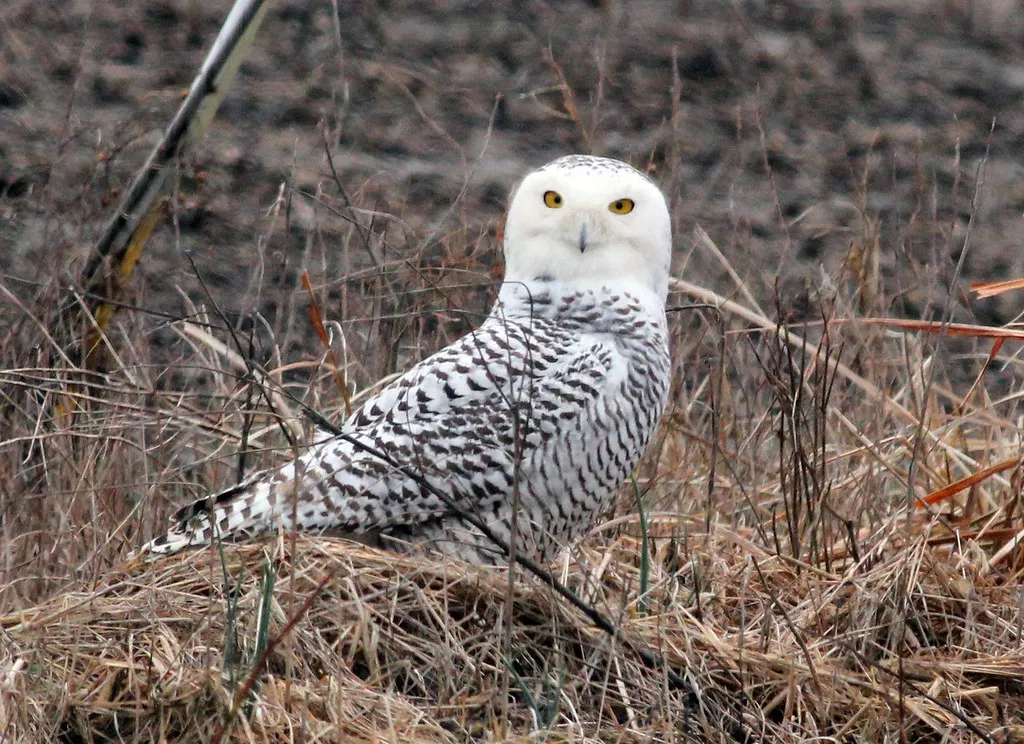
Image Source
- Scientific name: Bubo scandiacus
- Life span: up to 9 years in the wild
- Size: length of 20-28 inches, wingspan of 49-59 inches
- Weight: 3.5-6.5 lbs
- Origin: Arctic regions of North America, Europe, and Asia
The snowy owl is a beautiful bird. The males have predominantly white plumage that becomes whiter as they mature, and they have eyes that are a striking, cat-like yellow. Females and young birds have markings that are dark brown or black.
Throughout the long summer days, snowy owls hunt for animals like lemmings and ptarmigans in the Arctic Circle. Throughout the winter, they migrate south to Canada, Alaska, and the far north of the US.
You may often see them sitting on the ground at their hunting places. They will also perch on fences, hay bales, power or telephone poles, and abandoned buildings. They examine the tundra or fields where they prey by flying low to the ground.
It is uncommon to see a snowy owl, particularly when their numbers are decreasing rapidly.
Barred Owl

Image Source
- Scientific name: Strix varia
- Life span: up to 24 years in captivity
- Size: length of 16-25 inches, wingspan of 38-49 inches
- Weight: 1-2 lbs
- Origin: North America
The great horned owl and the barred owl are almost the same size, but the barred owl weighs significantly less. They have prominent bars all over their body and are a mottled brown and white color. On the rest of their bodies, the breasts’ bars are both vertical and horizontal.
These birds are not loud ones. While they often remain silent, sometimes you may hear them calling out throughout the day.
Barred owls like dense forests, whether they are in a marsh or high on a mountain. They are not seen in urban areas or on plains. They are widespread throughout the eastern US and as far north as Canada. The birds’ range has grown recently, and now the Pacific Northwest is home to colonies of them as well. they are non-migratory birds and settle in one location for all their lives. They will, however, travel great distances to hunt if they are unable to obtain food.
Conclusion
Nebraska is home to a variety of owl species, including the Great Horned Owl, the Barn Owl, and the Short-eared Owl. These birds play an important role in the state’s ecosystem and can be found in a range of habitats, from grasslands to forests. While some species face threats such as habitat loss and pesticide use, efforts to protect their populations are underway. By continuing to monitor their populations and conserve their habitats, we can help ensure the continued presence of these majestic birds in Nebraska۔
Frequently Asked Questions (FAQs)
Q: What types of owls can be found in Nebraska?
A: There are several species of owls that can be found in Nebraska, including the great horned owl, the barn owl, the screech owl, the short-eared owl, and the long-eared owl.
Q: What habitats do owls in Nebraska prefer?
A: Different species of owls have different habitat preferences, but generally speaking, owls in Nebraska can be found in a variety of habitats including forests, grasslands, wetlands, and agricultural areas.
Q: Are owls in Nebraska active during the day or at night?
A: Most species of owls are primarily nocturnal, meaning they are active at night. However, some species, such as the burrowing owl and the short-eared owl, are active during the day as well.
Q: What do owls in Nebraska eat?
A: Owls in Nebraska feed primarily on small mammals such as mice, voles, and rabbits. Some species also eat birds, fish, and insects.
Q: Are owls in Nebraska endangered?
A: While some species of owls are listed as threatened or endangered in other parts of the country, none of the species of owls found in Nebraska are currently listed as such. However, loss of habitat due to human development and other factors can threaten owl populations.
Q: When is the best time to see owls in Nebraska?
A: Since most species of owls are nocturnal, the best time to see them is at night. However, some species may be active during the day as well. It’s important to note that owls are generally shy and elusive, so spotting them can be difficult even in areas where they are known to reside.


![8 Beautiful hummingbirds in Nebraska [Pictures + IDs]](https://birdsology.com/wp-content/uploads/2023/03/31402818927_0b9af108e2_b-600x400.jpg.webp)
![11 Species Of Hawks In Nebraska [Images + Ids]](https://birdsology.com/wp-content/uploads/2023/02/17484880426_04703d85b4_b-600x400.jpg.webp)
![12 Beautiful Red Birds in Nebraska [Images + IDs]](https://birdsology.com/wp-content/uploads/2023/03/45-14-600x400.jpg.webp)
![3 Types of Doves in Nebraska [Images + IDs]](https://birdsology.com/wp-content/uploads/2023/09/51966837857_e62c6fbc37_b-600x400.jpg.webp)
